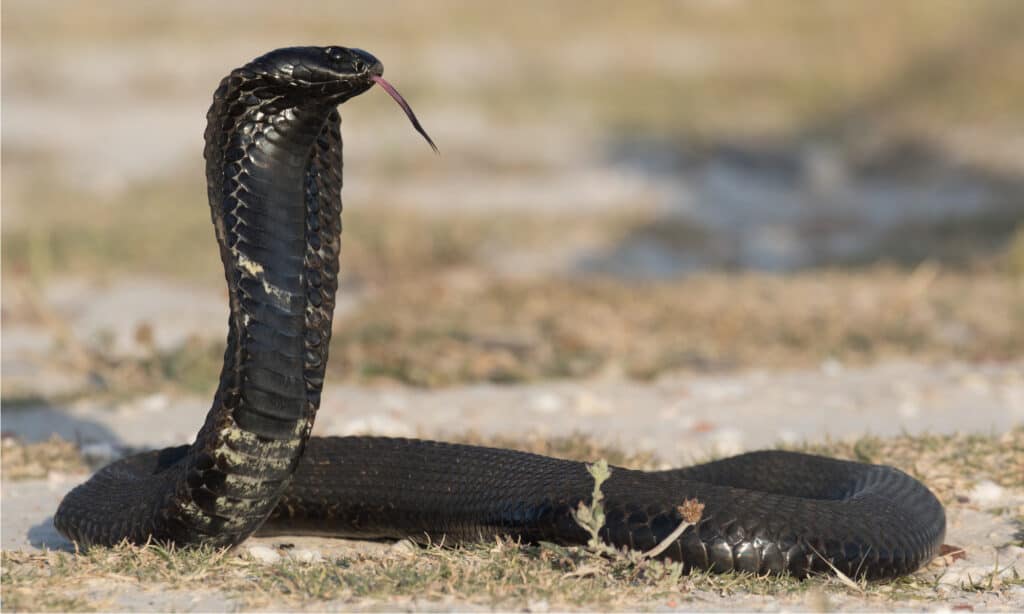Rinkhals Snake
Hemachatus haemachatus
This snake is known for playing dead as a defense against predators.
Advertisement
Rinkhals Snake Scientific Classification
- Kingdom
- Animalia
- Phylum
- Chordata
- Class
- Reptilia
- Order
- Squamata
- Family
- Elapidae
- Genus
- Hemachatus
- Scientific Name
- Hemachatus haemachatus
Read our Complete Guide to Classification of Animals.
Rinkhals Snake Conservation Status
Rinkhals Snake Facts
- Prey
- Frogs, toads, rodents
- Name Of Young
- Neonates, snakelets
- Group Behavior
- Solitary
- Fun Fact
- This snake is known for playing dead as a defense against predators.
View all of the Rinkhals Snake images!
“This snake is known for playing dead as a defense against predators.”
The Rinkhals snake sometimes called the ring-necked spitting cobra, is a venomous snake native to South Africa. It can grow to a length of three and a half feet. This snake can rear up and spread its hood like a true cobra but belongs to a different genus. It has a diet of frogs, toads, and rodents.
4 Rinkhals Snake Amazing Facts
• It’s an expert at playing dead by turning onto its back and opening its mouth
• It can spit venom a distance of nine feet aiming at a predator’s eyes
• Instead of laying eggs, it gives live birth to 20 to 35 snakelets
• The size of a Rinkhals snake baby is six to seven inches
Where to Find a Rinkhals Snake
The Rinkhals snake is from South Africa. It’s found in Cape Town, Eswatini and Johannesburg. It lives in a grassland, wetland, or scrubland habitat.
The Rinkhals snake is sometimes found basking on rocks during the day to warm its body. These snakes also hide beneath leaves, sticks or other vegetation. They live in a temperate to tropical climate and are most active in the summer and fall.
Rinkhals Snake Scientific Name
Hemachatus haemachatus is the scientific name of the Rinkhals snake. They are also called ring-necked spitting cobras. Though it’s referred to as a ring-necked spitting cobra, it’s not a true cobra. This is because it isn’t in the Naja genus.
A Rinkhals snake is an Elapid meaning it belongs to the Elapidae family. They are in the Reptilia class.
The Rinkhals is a monotypic genus. This means it’s the only member of its particular group.
Rinkhals Snake Population & Conservation Status
The IUCN Redlist of Threatened Species doesn’t display a population total connected to Rinkhals snakes. However, the population of this Elapid is described as stable and even abundant with a status of Least Concern.
How to Identify a Rinkhals Snake: Appearance and Description

Rinkhals Snake
©Andre Coetzer/Shutterstock.com
The body of a Rinkhals snake is black or dark gray with two or three bands of white running across its chest. Other Rinkhals snakes have a combination of black with yellow bands. The coloration of this Elapid differs a little depending on where it lives in South Africa. The scales of a Rinkhals snake are ridged or keeled, instead of smooth.
As an adult a Rinkhals snake can be from three feet to three and a half feet long. In the world of venomous snakes, it’s considered to be medium in size. It has a thick body and the ability to raise its pointed head and expand its hood.
How to Identify a Rinkhals Snake:
• Black or dark gray body
• Two or three wide bands of white on its chest
• A thick body
• Ridged scales
• Small size head with round, dark eyes
Rinkhals vs Cobra
When you see a video of a Rinkhals snake raising the top half of its body and expanding its hood, it’s easy to assume it’s a cobra. After all, this is very familiar behavior from a cobra. Well, while the Rinkhals snake is a type of cobra, it isn’t considered a true cobra. There are similarities and differences between the Rinkhals snake and true cobras.
Along with rearing up and displaying its hood, another similarity a Rinkhals shares with some true cobras is it can spit venom. Both true cobras and Rinkhals snakes can spit venom a distance of well over nine feet.
True cobras and Rinkhals snakes share a similar diet of frogs, toads, and rodents.
When it comes to differences, the first one to note is Rinkhals are not included in the Naja genus. The Rinkhals is in its own genus known as Hemachatus. The Naja genus includes true cobras such as the Mozambique spitting cobra, the Indian cobra, and the Egyptian cobra along with others.
A second difference has to do with reproduction. Rinkhals snakes give live birth to their young while true cobras lay eggs.
You’ll find another difference in the texture of the scales of Rinkhals snakes and true cobras. Rinkhals snakes have keeled or ridged scales whereas true cobras have smooth scales.
Rinkhals Snake Venom: How Dangerous Are They?
The Rinkhals snake is considered extremely venomous. However, bites from this snake are rare.
If this snake encounters a human in its grassland habitat, it’s more than likely going to rush toward a hiding place. In other instances, this snake tries a very different tactic to avoid harm.
It plays dead in an effort to make the threat go away. Of course, there are times when a Rinkhals snake rises up and expands its hood as a way to scare off a threat. It can spit its venom a distance of over nine feet.
Anyone who is hit in the eyes with this snake’s venom is going to experience burning, blurry vision, and can even suffer blindness. The venom should be washed out of the eyes right away. Then, seek treatment at a nearby hospital to evaluate and address any damage to the eyes. Sometimes this snake’s venom can damage the cornea of a human or animal’s eyes.
A bite from this snake is painful and causes swelling as well as tissue damage.
If someone does get a bite from a Rinkhals snake, the first thing to do is seek medical treatment at a hospital. Don’t wrap the wound or try to remove the venom. There are effective antivenoms for this snake’s bite.
On a positive note, death from this snake’s bite is a rarity. The last human death from a Rinkhals snake bite was recorded 40 years ago.
Rinkhals Snake Behavior and Humans
Rinkhals snakes are timid and avoid conflict if possible. Unfortunately, these snakes sometimes find their way into areas where they encounter pet dogs. Dogs that bark at, charge, and otherwise threaten this snake are sometimes bitten. Taking the dog to a veterinarian right away is necessary to treat this venomous snake’s bite. A veterinarian will know how to render treatment to a dog that’s been bitten by a venomous snake.
If a person happens upon a Rinkhals snake lying on its back in a grassy area or elsewhere, it’s not advisable to try to touch or move the snake. There’s an excellent chance the snake is still alive! These snakes are very convincing at playing dead to avoid a conflict. They turn over on their back, lie still and even open their mouth to appear injured. Picking up a Rinkhals snake that’s playing dead can definitely lead to a bite. The best thing to do is to leave the snake alone and walk away.
Similar Animals
View all 114 animals that start with RRinkhals Snake FAQs (Frequently Asked Questions)
How venomous is a Rinkhals snake?
Rinkhals snakes are extremely venomous. A bite from this snake needs immediate medical treatment.
What happens when a Rinkhals bites you?
The bite of a Rinkhals snake is very painful. It starts to swell quickly, and the venom can begin to damage tissue. The person is likely to feel nauseous and dizzy as well.
Can a Rinkhals spit venom?
Yes! A Rinkhals snake can spit venom more than nine feet. The snake may jerk its head forward when it spits or remain still and upright. It can send venom out from either position.
How do Rinkhals hunt?
Rinkhals snakes hunt by moving in a stealthy way through their grassland, wetland, or scrubland habitat. They inject venom into their prey. When their prey dies, the snake swallows it. It can take hours for this snake to digest its prey.
Are Rinkhals aggressive?
No, these are not aggressive snakes.
Where do Rinkhals live?
Rinkhals live in South Africa. Their territory includes Cape Town, Eswatini, and Johannesburg. Grasslands, scrublands, and wetlands are all habitats of this Elapid.
What do Rinkhals eat?
Rinkhals have a diet of frogs, toads, and rodents. Sometimes they eat smaller snakes and birds’ eggs.
What is the difference between a Rinkhals and a (true) cobra?
One difference is Rinkhals snakes belong to the Hemachatus genus while true cobras belong to the Naja genus.
A second difference is Rinkhals snakes have ridged scales whereas true cobras have smooth ones.
Rinkhals give live birth to their young. This means the snake is ovoviviparous. Alternatively, true cobras lay eggs.
Thank you for reading! Have some feedback for us? Contact the AZ Animals editorial team.


















